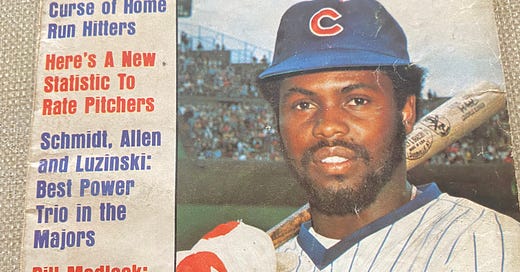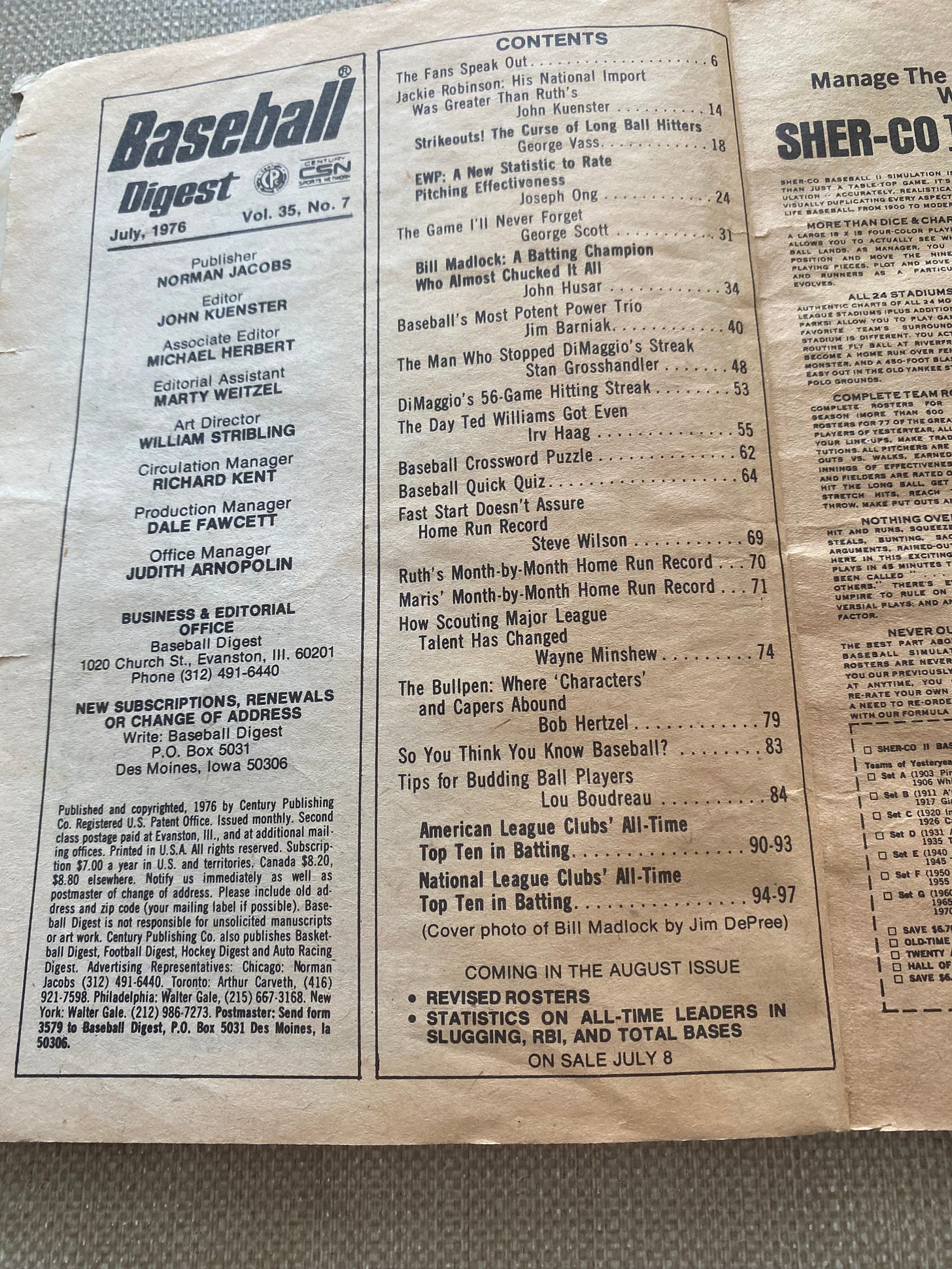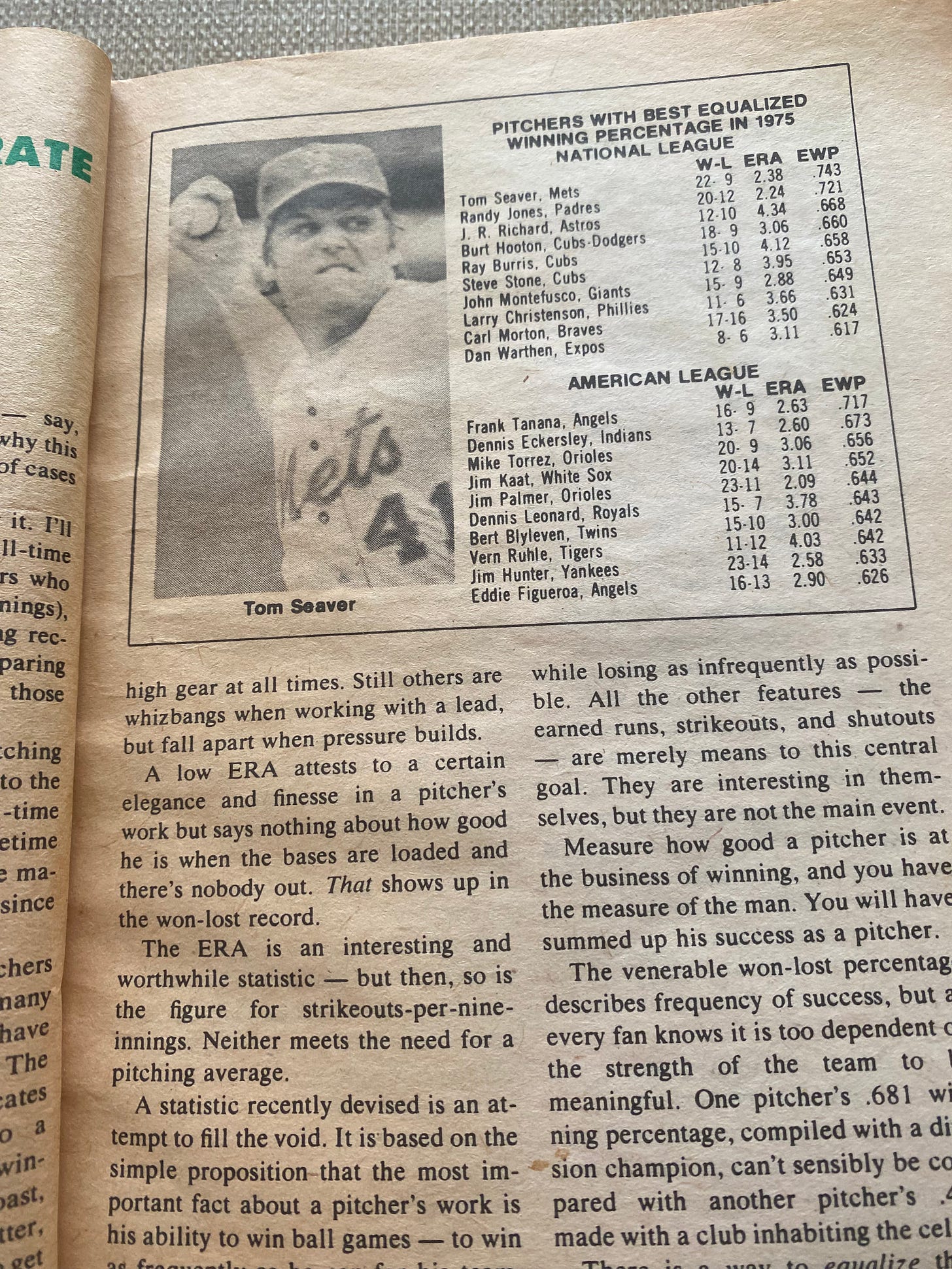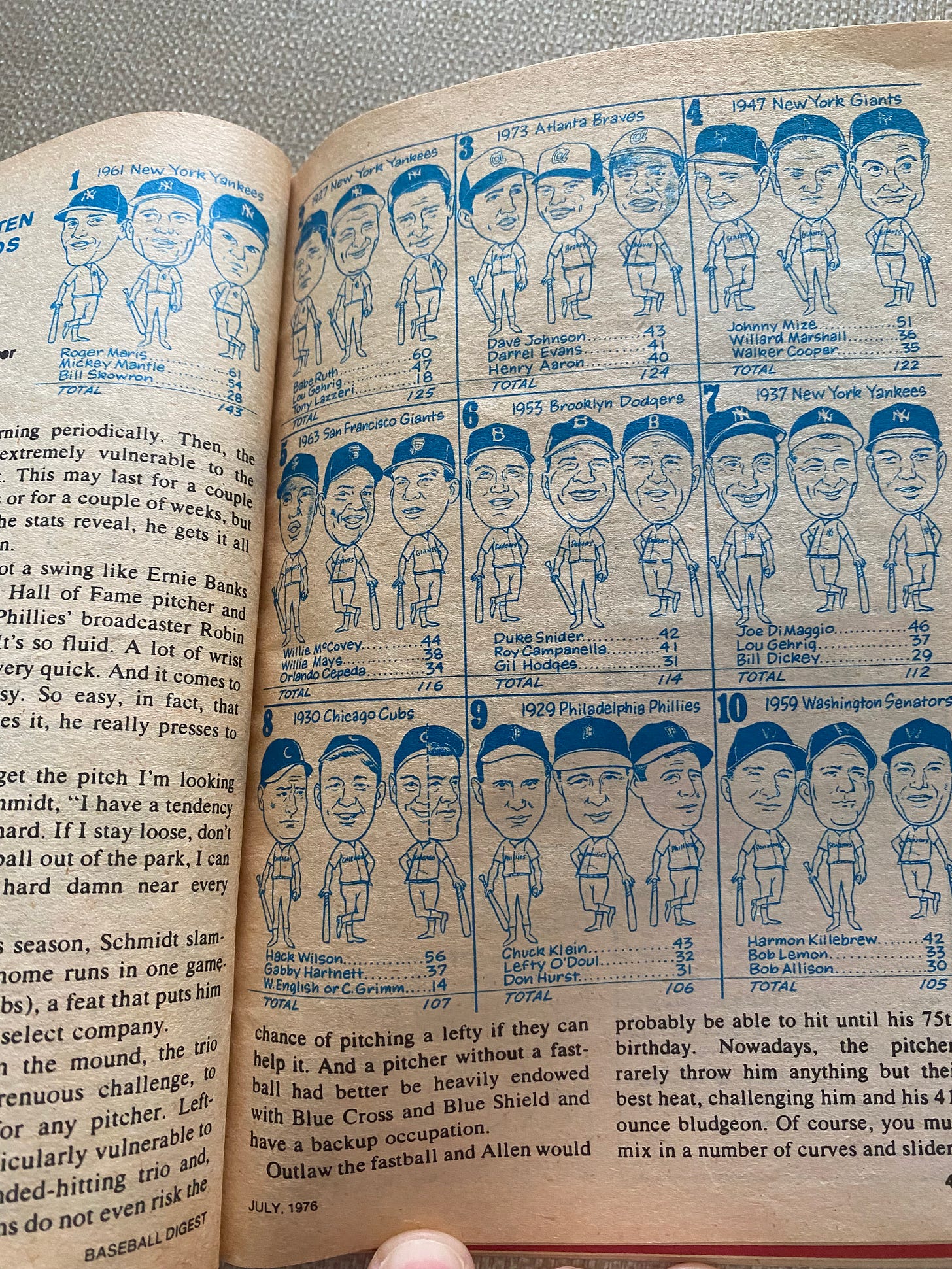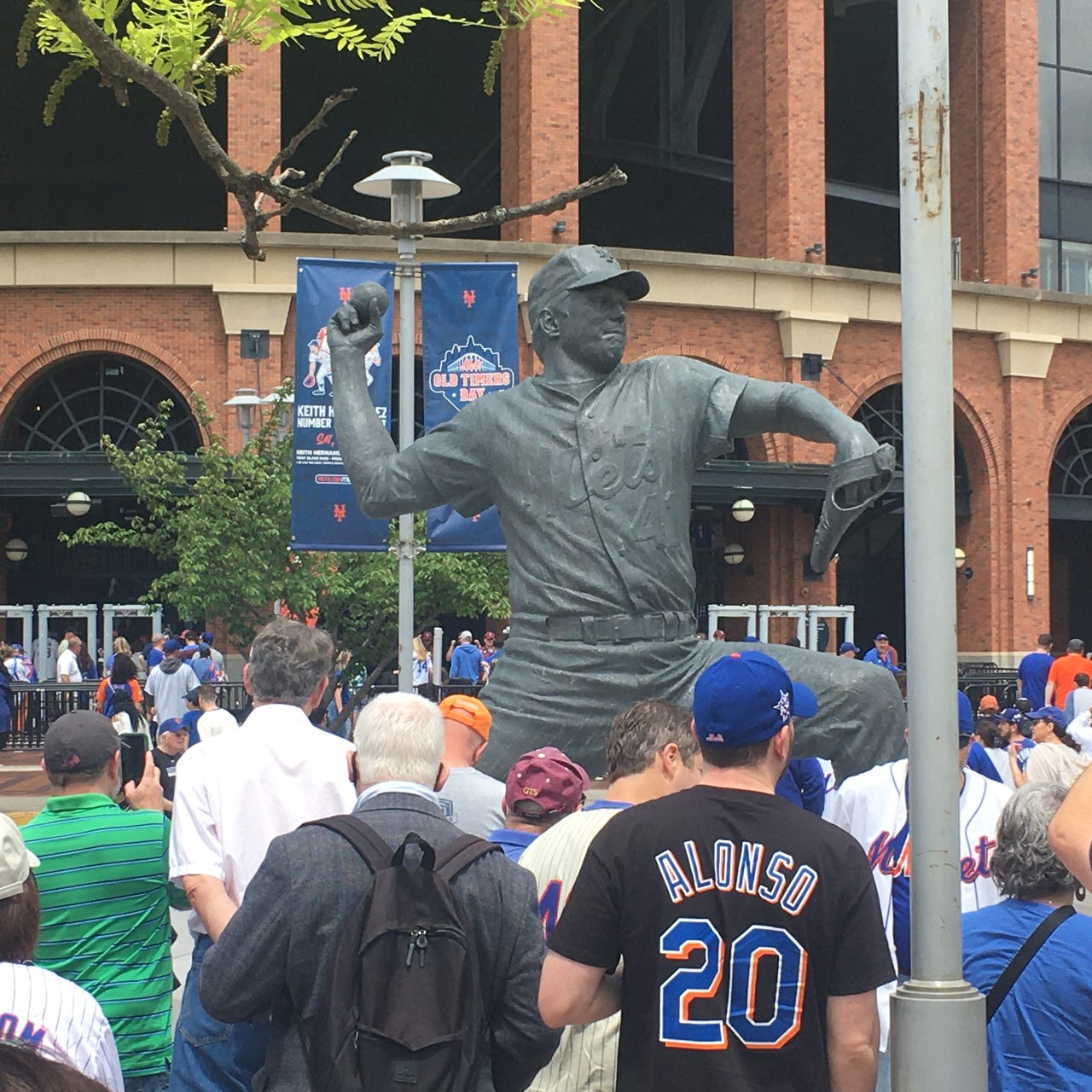July 1976
July 1976 was our nation’s bicentennial, and not only did Baseball Digest celebrate it by coloring their logo red, white, & blue, but cover subject Bill Madlock played for a team with a red, white, and blue color scheme. That might have been intentional, but I’ll give their staff credit for that choice.
For the umpteenth time this issue contains yet another article that chronicles the wacky shenanigans that are found in bullpens as relievers search for a way to pass the time. There’s also another article that complains about the current culture in the game; that’s an evergreen. There are two of those this month. One of them is about scouting; one of the old timey scouts featured in the piece takes time to point out that it’s harder to find talent because “kids don’t play as much today.” The other points out that modern day sluggers strike out much more frequently than their predecessors had. The more things change…
I’m always happy to read about a new stat, more specifically one which seeks to find a more accurate way to measure a player’s value. This month an article tries to come up with a one size fits all metric that could be used for a pitcher in the way that batting average was at the time. Presenting… equalized winning percentage! This used an unnecessarily complicated methodology; it tried to somehow measure a pitcher’s individual winning percentage against his team’s winning percentage to measure his effectiveness but trying to make sense out of the formula was making my head hurt. Needless to say this proposed stat never took off. For what it’s worth this is what the 1975 leaderboard looked like.
A couple of articles that discuss history caught my eye. I sometimes forget how long ago these issues were published. At the time this one came out, the 1940’s were still relatively recent. For perspective Joe DiMaggio’s 56 game hitting streak would have been the equivalent of a magazine article today looking back at a game from 1990. Yikes. This issue included an interview with Cleveland third baseman Ken Keltner, who helped end DiMaggio’s streak by making two hit saving plays. This issue also included an anecdote about a game in 1946 in which Ted Williams beat the famous shift by slicing a hit into left field which he turned into an inside the park home run! That hit, which happened in the first inning of a game in September, would be the only run in that game.
Finally, this issue included an article calling Mike Schmidt, Greg Luzinski, and Dick Allen of the Phillies the best home run trio in the game. That was premature, Allen was nearing the end of his career and only hit 15 homers in 1976. I’m more interested because of the graphic that showed who were the most prolific trios at the time. The 1973 Braves team never fails to crack me up, not just because this chart misspelled the name of Darrell Evans. That Davey Johnson season was one of the strangest outliers in league history. He hit 43 home runs in 1973, his next highest single season total was 18. During the steroid era I liked to use that season as a counter argument whenever someone would channel The Crucible by falsely accusing any player whose home run totals would suddenly jump. Sometimes unusual seasons just happen.
Most Memorable Moment - Baltimore Orioles
Original 1976 selection: Brooks Robinson’s tour de force in the 1970 World Series
My 2025 choice: 2,131
I hate to take the honor away from Brooks Robinson. Some of those plays he made remain astonishing all these years later. To go that deep into foul territory to field a hot grounder, yet still be able to get enough on the throw to throw Lee May out at first? Yowsa! Plus, by all indications Robinson was an exceptionally nice man. But there is only one choice.
The day that Cal Ripken Jr. broke Lou Gehrig’s consecutive game streak was so special. I believe the talking point that it “saved” baseball is a little exaggerated, but it is true that after the destructive 1994 strike which caused the cancellation of the World Series the game could have really used a feel good moment. Luckily the schedule worked out so that the record breaker was a home game.
The Orioles and the league pulled out all the stops. The game was a national broadcast on ESPN. Dignitaries such as Bill Clinton and Joe DiMaggio were in attendance. I still wonder how many strings they had to pull to get Joe D to attend an event for which he wasn’t the center of attention. Ripken himself showed a flair for the dramatic; he hit a home run in the 4th inning because of course he did.
In the games leading up to the date there were banners on the outside of the B&O warehouse that listed the running tally of consecutive games, which would change once each game became official. When game #2,131 became official the number change was accompanied by balloons and confetti and flashbulbs and a roaring applause from the sellout crowd. Ripken shared a moment with his family and tapped his heart in appreciation to the crowd, whose uproar went on. And on. And on.
Now, there was a postgame ceremony planned, but the game would have to end first. The passionate reaction from the fans was making that impossible. It wasn’t until Bobby Bonilla and Rafael Palmeiro pushed Ripken back onto the field so that he could begin his famous jog around the perimeter of Camden Yards, sharing handshakes and high fives with the fans seated in the front row, that the game could finally continue.
Ripken extended the streak to 2,632 before he finally sat out a game. In retrospect it is even more amazing. For more than 15 years he never missed a game, while playing a physically draining position. No foul balls off his foot, no pulled hamstring, no inadvertent injury from a takeout slide. Despite what some conspiracy theorists may believe (Google Cal Ripken Jr./Kevin Costner) no off field incidents or accidents that could have caused him to miss a day or two. He punched the clock every day, and in doing so he symbolized what so many of us love about the sport. The game is the daily soundtrack of our summer. A tough loss? It’s OK, there’s another game tomorrow.
It’s one of those unbreakable records. Not only is there more awareness about the benefits of load management, but no organization would let things get to the point where any decision about playing time is out of management’s hands. Imagine someone trying to convince Ripken in 1992 that it would be in the best interests of himself and the team to take a day off. Wouldn’t happen. The same conversation could have been possible in 1985 before the streak had become a thing. But thank goodness that conversation did not happen. Game 2,131 was an unforgettable evening.
Meet the Nominees - Outkast
Outkast’s appearance on this year’s ballot was greeted with a lot of “about f***ing time!” reactions. They are more than simply an obvious choice; they are an act that should have waltzed in as first year eligibles, no questions asked. They check virtually every box, in both objective and subjective categories. They were popular, have a catalog consisting of multiple songs which have stood the test of time, distinctive, groundbreaking, and influential. Outkast are far and away the biggest slam dunk choice on this year’s ballot.
They were far from the first southern based hip-hop act to break big nationally, but they were instrumental in helping cement the ATL as a hotbed. They immediately stood out; the sharp contrast between the 2 MC’s created a most unique blend. Big Boi had a hundred miles a minute flow. It did not seem possible that a human being could rhyme that quickly. Andre 3000’s deep drawl perfectly evoked a specific mood; it made their music sound gritty and soulful.
Their first 5 albums are all stone cold classics, and they showed exponential growth with each succeeding release. The earlier releases dominated R&B radio, but this point is crucial. They did not make compromises to reach a larger audience. Essentially the mainstream turned to meet them rather than the other way around. They reached #1 with the brilliant Ms. Jackson, a song that sounded like Outkast and no one else.
All of which set the stage for the triumph of Speakerboxxx/The Love Below. Essentially two separate solo albums by Andre & Big Boi that were packaged together, it was almost a hip-hop version of The Beatles’ White Album in that it simultaneously demonstrated all aspects of their greatness while also making it clear that their musical differences were going to make it difficult to remain together much longer.
Their music was inescapable at this time, but it wasn’t overwhelmingly so. Hey Ya! was ubiquitous, but as often as I heard the song I never got tired of it. No exaggeration, Andre’s “alright, alright, alright” just might be my single favorite musical moment of the aughts. The Way You Move also hit #1, they won the Grammy for Album of the Year, and they were as big as a band could get.
That would turn out to be it for the duo; they starred in the movie Idlewild, but the soundtrack would become their final release. Big Boi has put out some solo records and Andre 3000 has become a wonderfully eccentric public figure. He’s almost like Bill Murray; one of those celebs who appears in some of the most random places. Nothing he does comes as a surprise. If you told me that he was seen training dolphins at an aquarium, I’d say sure, that makes sense. He marches to his own drummer; his most recent release was an album of jazz flute music.
Outkast’s classic run lasted for one hell of a decade; their place in musical history is fully secure. The fact that they are the only hip-hop act on this year’s ballot, which opens up a clear lane, makes their induction this year a near certainty. The fact that they cultivated such a huge following outside of hip-hop as well adds even more potential supporters. It will have taken longer than it should have, but better late than never.
Biggest Billboard Hot 100 hit: Hey Ya!
My personal favorite: Hey Ya!
If elected, will they perform at the ceremony?: I would hope so. I don’t get the impression that there are hard feelings between the two, the breakup was more of a reflection of the fact that their music was veering in different directions and they played a reunion tour 10 years ago. The only potential fly in the ointment is that Andre can have that Neil Young tendency to act on a whim. Unless he is in a flaky mood that night I would expect to see them perform.
Big George
George Foreman, who passed away on Friday, led multiple lives over the years. People who largely know him as the avuncular pitchman selling his eponymous indoor grilling machine would be shocked to know that he was once the glowering villain of heavyweight boxing. Despite what the F. Scott Fitzgerald line says, his was an American life that had a second act, if not a third.
Foreman won the Olympic heavyweight boxing gold medal in the 1968 Olympics, and upon turning professional he quickly rose up the ranks, earning a title shot against Joe Frazier in 1973. Because he was deemed too inexperienced and too one dimensional he was the overwhelming underdog, with one important exception. Howard Cosell told everyone who would listen that Foreman would win the fight. Years ago HBO produced an outstanding documentary on Cosell’s life which unfortunately does not appear to be streaming anywhere. A segment was devoted to the Foreman/Frazier fight, a bout which resulted in the famous “Down goes Frazier!” line. Documentary footage showed a gloating Cosell proclaiming “I told you so” following Foreman’s knockout victory.
Foreman held the title until losing to Muhammad Ali in the legendary Rumble In the Jungle match in 1974. Foreman stuck around for a bit, eventually retiring and retreating from the public eye. Years later Sports Illustrated ran a Where Are They Now feature on Foreman, in which it was revealed that he had become an ordained minister and had opened up a youth ministry in Texas. He had also clearly mellowed with age, demonstrating the friendly personality for which he has since become best known.
Now in his forties, he returned to the ring the help raise money for the ministry. At first it looked like a joke - he didn’t exactly have a sculpted figure - but what he did still have was a powerful knockout punch. He improbably defeated Michael Moorer in 1994 to regain the undisputed heavyweight crown at the age of 45.
He would eventually retire for good, but he spent the remainder of his days as one of America’s most likable celebrities. From those ever present commercials for the George Foreman Grill to the jokes about the fact that he named 5 of his sons George, he always seemed to bring a smile to people’s faces, quite a contrast from his image in the 1970’s. He was one of the last remaining figures from that golden generation of heavyweight boxing. Foreman was 76.
50 Years Ago - Saturday Night Live With Howard Cosell
Remember, kids, there was a weekly network series which premiered in 1975 called Saturday Night Live, but it was NOT the NBC show that is still on to this day. That show was initially known as NBC’s Saturday Night. The actual original Saturday Night Live was a primetime variety series airing on ABC hosted by noted song & dance man/legendary comedian… Howard Cosell? (BTW, I chose to write about this show before I learned of George Foreman’s death.)
This could be read as an attempt to create a new version of The Ed Sullivan Show, which had only ended its lengthy run 4 years previously. Roone Arledge was the producer, and he was savvy enough to realize that it would be a losing bet to completely replicate Sullivan; in 1975 there wasn’t much of an audience for the jugglers and acrobats that helped fill out the Sullivan hour. So, in addition to the wide range of acts that Cosell would introduce the show would also need a repertory troop to perform some sketch comedy.
The members of that troop? Bill Murray, Christopher Guest, and Brian Doyle-Murray. That’s a lot of talent for a show that was such a notorious flop. And what a flop it was. All credit to Cosell; he built a legendary broadcasting career even though he had a face and voice best suited for the newspaper. But in this instance Cosell really leaned heavily over his skis; he kidded himself into thinking he was a performer. In that same HBO doc that I referenced above there was a great sequence concerning his forays into pop culture, such as his appearances in Woody Allen movies and on The Odd Couple. Tony Randall told a story about Cosell’s insistence that he knew how to act. The crew goaded him, telling him that he was doing great and just needed to play bigger in the next take. Cut to Cosell doing an exaggerated triple take after Oscar Madison called him Needle Nose. Amazing.
I watched this show once or twice, but I’m not sure how much of it I actually remember as opposed to any of the numerous other TV appearances that Howard Cosell made over the years. But I do remember this. If Cosell was going to update Ed Sullivan, then he needed his own Beatles. Enter the Bay City Rollers. He leaned into making them happen big time, including breathless footage of their plane landing at JFK with screaming fans awaiting their arrival. The Rollers were… fine. Their most famous hit Saturday Night was a perfect pop song, and they had a brief run of American success, but they were far from legendary.
In the end, the show was quickly cancelled and if it is discussed at all these days, it is as part of a montage of the biggest failures in TV history.
Closing Laughs
Thank you all for subscribing. Have a terrific day and I will see you all again on Wednesday.

